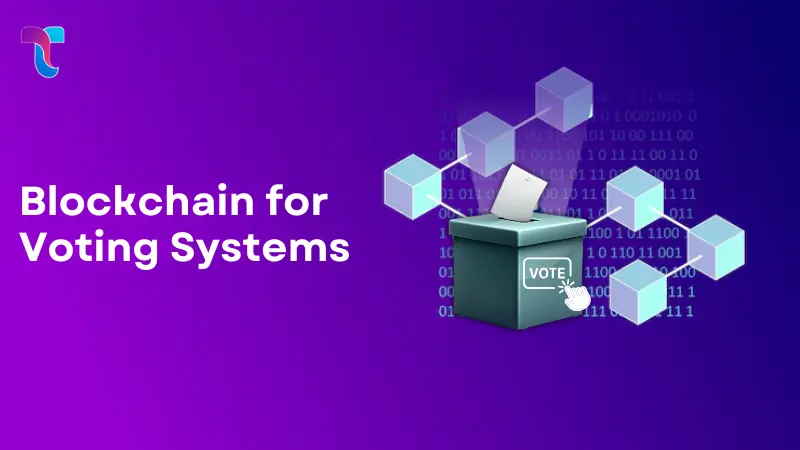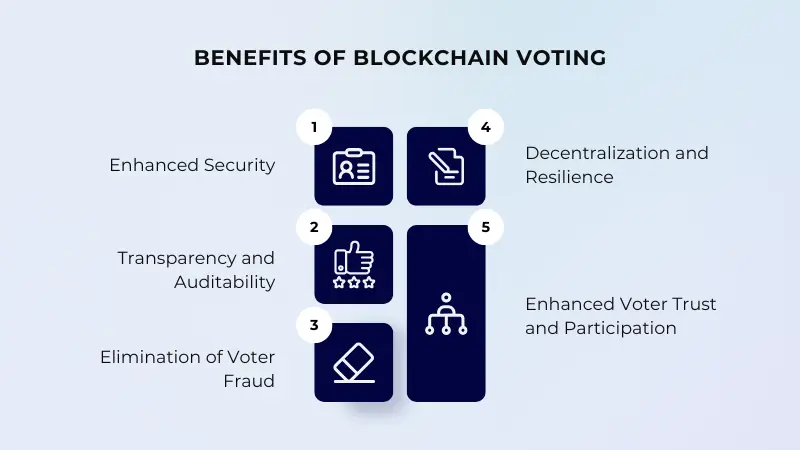Day by day, the world is becoming more advanced and digitalized; everywhere you look, you’ll see some major changes that are absolutely noteworthy.
Among these changes, today we are going to discuss voting systems and learn how they’ve changed from traditional voting systems.
In today’s world, where elections are more often questioned about trust in democratic systems, we all need a voting process that is more secure, transparent, and tamper-proof. Enter blockchain technology; the same technology that powers cryptocurrencies has now been explored as a powerful tool to revolutionize voting.
By prioritizing its decentralized, immutable, and transparent nature, blockchain has the power to prevent fraud, build voter confidence, and make elections easier than ever before. Just imagine being able to cast your vote from anywhere in the world, verify it on a public ledger, and know that no one can change it. Sounds interesting.
So, this is not just a futuristic dream; it is a program that has already started capturing the global voting systems. In this article, we’ll explore how blockchain brings transparency and trust to elections and what it looks like.
Let’s start!
Understanding Blockchain Technology
In today’s world, if you are unfamiliar with blockchain technology, you are falling behind others.
Blockchain is not just a revolutionary technology; it is also a great initiative that has gained the attention of worldwide users. The name “blockchain” typically refers to its structured data in blocks that continuously form a chain one after the other.
Here, each block stores crucial data, such as a list of transactions, a timestamp, and a unique identifier, which is also known as a cryptographic hash. Meanwhile, this hash is generally produced from the block’s contents and the hash of the previous block, ensuring that each block is significantly connected to the others.
For example:
Blockchain is like a shared digital ledger where every vote is recorded in a block and linked to the previous one, typically forming a secure chain. This process is continuous because everyone is able to see the same record, and records cannot be altered; thus, it ensures transparency, prevents tampering, and builds trust in the voting process.
Furthermore, blockchain is decentralized and distributed, which indicates that no single entity can manipulate it. Instead, multiple nodes on the network each have a copy of the blockchain, keeping the ledger in sync. This setup guarantees that once data is recorded and confirmed, it becomes almost impossible to alter or delete.
Challenges in Traditional Voting Systems
If we compare traditional vs. blockchain-based voting systems, then here are some major challenges generally faced in traditional voting systems.
- Security: In a traditional system, voting is commonly performed on paper-based systems. This sometimes results in human error, tampering, and fraud.
- Transparency: In the traditional voting system, transparency is considered another major challenge. In this case, voters and election observers might face limited visibility on voter count, which could affect the accuracy of the election results.
- Efficiency: Comparatively, traditional voting systems can be laborious, especially when millions of voters are participating in elections. This process of counting votes, whether by hand or through a machine, can take days or even weeks. Further, the transportation of ballots and election officials leads to delays and inefficiencies.
- Voter Accessibility: The traditional voting system often asks voters to be physically available at the polling stations, which can be a serious challenge for people with disabilities, elderly individuals, or those living in remote areas.
- Cost: In terms of cost, the traditional voting system is costlier due to the cost of hiring election workers and setting up polling stations. Not only this, but the need for extensive security measures to shield physical ballots typically leads to an overall cost.
How Blockchain Improves Voting Systems
Through secure, transparent, and verifiable mediums, blockchain improves voting from start to finish. Here is how it works:
Voter Registration & Authentication
- In blockchain voting, voters are offered a unique digital identity, which is often used for verification using cryptographic keys.
- This prevents duplicate registrations and ensures that only eligible voters can participate.
Casting the Vote:
- Next, voters further cast their ballot digitally through a secure platform.
- Here, each one of the votes is documented as a transaction on the blockchain and encrypted for privacy.
Immutable & Transparent Record:
- Once a vote is added to the blockchain, it cannot be altered or tampered with, ensuring immutability.
- The whole voting ledger is visible to authorized participants, permitting anyone to verify that votes were counted correctly without revealing who has voted for whom.
Automated Counting with Smart Contracts:
- Once the votes are recorded, with the help of smart contracts in blockchain, the administration will automatically be able to tally votes in real time.
- This reduces human error, speeds up counting, and eliminates the need for intermediaries.
End-to-End Verifiability:
- Once we develop blockchain solutions for the voting system, voters will be able to check whether their vote was successfully recorded and included in the final count.
- This transparency will help in gaining trust and confidence in the election process.
Tamper Resistance & Security:
- As blockchain is decentralized, no single entity can alter the results.
- This prevents hacking and manipulation, which is extremely different compared to a centralized voting system.
Benefits of Blockchain Voting
Once you’ve understood how blockchain is improving the voting system, it’s time to talk about the core benefits. Which includes:
Enhanced Security:
With the help of advanced cryptographic techniques, blockchain guarantees that each vote is safely encrypted and recorded in an unalterable way. This technology further makes it challenging for malicious parties to hack into the vote data and provides higher security in safeguarding the integrity of the electoral cycle.
Transparency and Auditability:
Another valuable advantage of blockchain technology is its transparency and immutability. With the help of this technology, each vote cast on a blockchain-based voting system is recorded in a systematic manner that remains permanent and unchangeable on the distributed ledger. This secures accountability and enables a comprehensive audit of the voting process and trust among voters.
Elimination of Voter Fraud:
The traditional voting systems are generally vulnerable to diverse forms of voter fraud. So, by addressing all the unlawful practices, blockchain technology confirms that each vote is inconceivable to duplicate or alter. Also, by stopping the risk of dishonest activities, blockchain enhances the integrity and credibility of elections. Results: Every vote is counted accurately.
Decentralization and Resilience:
All the blockchain networks are decentralized, meaning that voting data is spread across different nodes rather than being kept on a single centralized server. This decentralized system enables voting that is highly immune to censorship, manipulation, and single points of failure. Unfortunately, if somehow a node in the network gets hacked or disabled, the integrity of the voting data stays unchanged, assuring the continuity and reliability of the electoral process.
Enhanced Voter Trust and Participation:
By creating a safe, fair, and unrestricted voting system, blockchain prevents tampering and fraud. This trust encourages higher voter turnout and participation, ensuring fairer outcomes and maximizing democracy by truly reflecting the will of the people.
Potential Risks & Challenges
While blockchain technology offers numerous benefits for voting, there are still some risks and challenges that need to be addressed before it can be widely adopted. This includes:
- Technical Challenges & Scalability: Large-scale elections generally involve millions of voters. Public blockchain may need to face challenges with slow transaction speeds, network congestion, and high costs during its peak usage.
- Voter Privacy & Anonymity: Since blockchain is a transparent concept, protecting voters’ identities while allowing public verification can be a bit tricky. So, here advanced cryptographic techniques like zero-knowledge proofs and ring signatures are widely required to balance privacy with transparency.
- Cybersecurity Threats: While blockchain is secure, the applications, like voting apps or devices, can still be hacked. Protecting the entire ecosystem from voter devices cannot be that easy.
- Public Trust & Adoption: Unlike traditional voting, blockchain voting will be completely different. People might not be able to move from paper ballots to a fully digital system. Here, education and awareness campaigns are vital to gain trust.
- Risk of Coercion or Vote-Buying: Remote voting might also allow someone to pressure a voter into revealing how they voted. This further leads to vote-selling and coercion.
To Sum Up
Blockchain technology is transforming voting systems by making them more secure, transparent, and trustworthy. From eliminating fraud to ensuring immutability, blockchain addresses many of the challenges typically faced by traditional elections.
While there are certain risks, such as technical challenges, voter privacy issues, and public resistance. There are also several benefits, like enhanced security, transparency, and increased voter confidence.
By partnering with Technoloader, governments and organizations are able to develop cutting-edge blockchain solutions, ensuring secure, scalable, and reliable systems. With their expertise, building transparent and tamper-proof elections becomes seamless.
 +91 7014607737
+91 7014607737
 info@technoloader.com
info@technoloader.com




